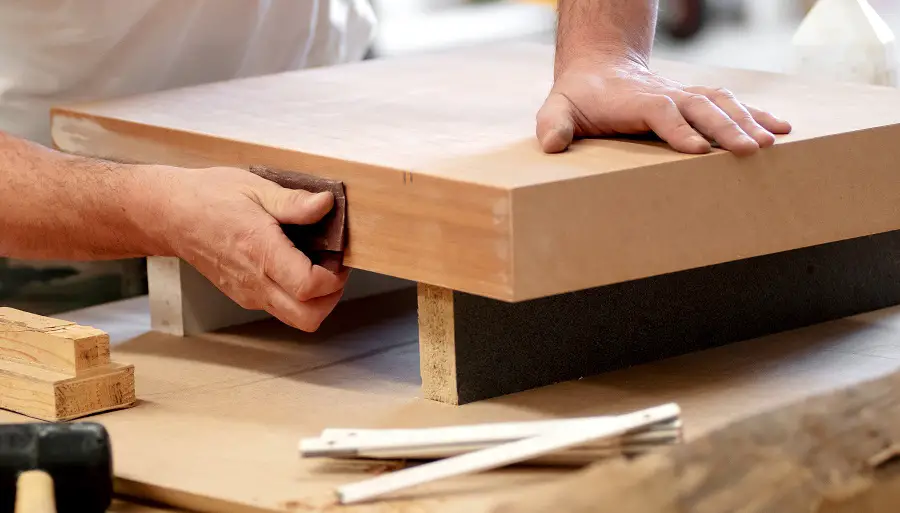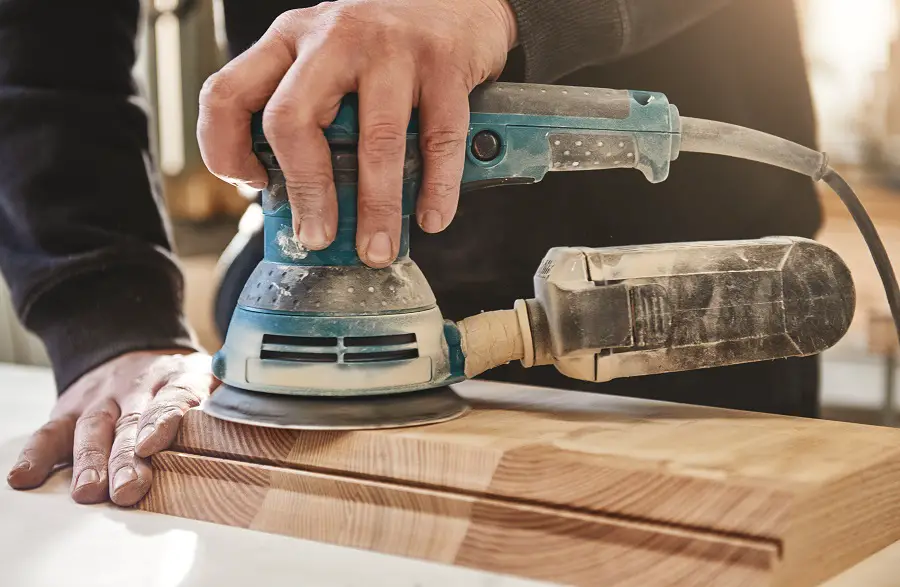The sanding of wood before planing and/or priming and varnishing is necessary to remove defects and traces left after mechanical processing with milling cutters or other machines. Whether hand sanding or mechanical, it should be started with a paper coarse enough to be able to effectively remove defects without leaving behind further scratches, this time from abrasive material. In general, the most suitable grits to start sanding machined wood to be finger-jointed and finished are between 80 and 120. Once the defects that have occurred during mechanical machining have disappeared, continue with 150 or 180 grit. The aim is that the surface should be sufficiently smooth so that no scratches occur when the polish or finishing material is applied. Find more information about the materials used for sanding here.
Although it all sounds clear and simple, there are some who say that sanding with a very fine grain - 400 or 600, for example - will stop the wood from staining or waxing. This is just a myth, as staining depends on many more factors. Here are some common misconceptions about sanding.

1. Very fine-grained sanding removes staining when coloring
Wood staining is primarily related to the type of wood, its uneven structure and density. Indeed, a totally unsanded wood will stain much more than a properly sanded one, but a 400 sanding will not remove staining if the wood is stained if the wood is loose, with twisted grain or other growth defects. Instead, fine sanding will result in a much lighter color, even if color by erasing.
The solution for stain-prone wood is the use of insulators and/or evening stains. They regulate the absorption of the stain into the wood and allow a uniform coloration. A compromise solution may be to apply a very thin coat of primer before the stain. The primer should be diluted (generally 1:1 with solvent) to avoid film formation. Apply it, allow it to soak into the wood and dry and then sand the surface as above. Then apply the stain solution. Caution, check the compatibility between primer and stain beforehand.
You can test for yourself whether advanced sanding prevents stains. Take a piece of stain-prone wood (poplar, wood with growth defects, etc.) and sand half at 180 max and the other half at 400. Apply the wood polish to the entire surface. You will see that the two sides will stain the same, the difference being the lighter color of the finely sanded area.
2. The very fine sanding makes the final look deeper and the final touch finer
Sanding very fine-grained wood has no impact on the final appearance or finish if a multi-layered film is applied. The statement is true only if finishing is done with a single coat of wax, oil or other product that is not sanded. As no further coats and refinishing of the film follow, the wood will feel as it remains from the last sanding. This is why a finer sanded wood (400, 600) will feel more pleasant than a waxed or oiled wood after sanding with 180.
The depth and sharpness of a film depends on the quality of the products used and the number of coats applied, and the brushstroke on how well and correctly sanding between coats. You cannot get a nice, smooth oiled or varnished surface without intermediate sanding of the applied layers. Fine sanding of wood not only does not help, but can lead to decreased adhesion of varnish film to wood. Signs of poor adhesion are film peel-off with light knocks or the appearance of whitish streaks even with very light scratching.

3. Very fine sanding closes the wood pores and prevents very dark staining
The fine dust resulting from fine sanding makes absorption more difficult, but does not prevent it. The result is a lighter colored mottled surface, not a uniform lighter colored surface. Very fine-grit sandpaper cuts the wood grain finely and leaves an almost polished-looking surface, but it does not behave uniformly and will not help achieve a pleasing appearance.
Closing pores to limit absorption is not done with wood dust by sanding. There are special products for this: sealers, pore-filling primers, various resins contained in staining solutions, etc. They lay evenly on the wood and limit absorption, and the appearance will be uniform and lighter in color.
4. Very fine sanding leads to unnoticeable fiber lift when finishing with water-based products
No matter how finely sanded, wood loves water and will absorb it as soon as it appears. The water gets into the wood fibers, swells them, and the ends of the fibers that have been severed by mechanical machining or sanding rise up. These fiber ends may be less coarse with fine sanding, but they exist and will feel the same if coated with varnish. Their "tarnishing" can be done with special products added to the composition of the baths and varnishes, but to get a nice tufted film you will still have to sand between coats.
To test this theory you can do as in point 1. Sand a piece of wood, half with 180 as the final grit and the other half with 400 or 600. Then apply a water-based varnish. You will also feel the surface roughness after the varnish has dried. Very fine sanding will reduce the roughness of the wood which will feel much smoother, but will not reduce its affinity for water.
I hope you find the above information useful. As always, additions are welcome. And if you have any questions or queries, please leave them below in the space provided. I will be sure to reply.




































Many thanks for the advice DVS.!
What do we do with the little grouted cracks?
I left them 24 hours to dry, sanded them and then gave them with Lomlux countertop varnish.
After about 3 months, in the heated room, the grout has risen 1-2 mm with varnish.
You're welcome! Glad if I can be of any help.
The link between wood moisture and environmental moisture is permanent. This means that solid wood will vary dimensionally with the variation of humidity in the room even if it has been properly dried. The humidity inside can vary with the season, which can result in small cracks. They disappear when the humidity returns to its original level. This play in the wood has led to cracking or swelling of the grout.
I'd leave it until after the heat is off. The swelling may go down. If it doesn't, you should let another winter go by to make sure no other changes occur, then redo the whole thing using wood shims to hide the cracks that have appeared or a more elastic putty.